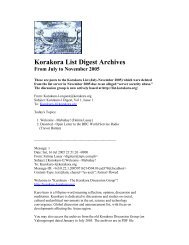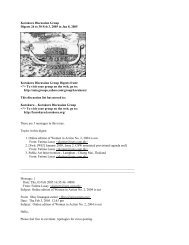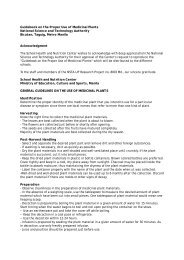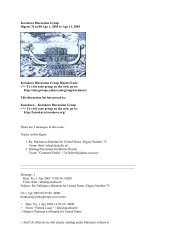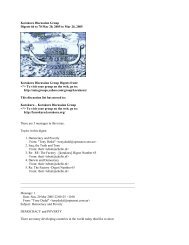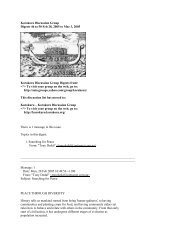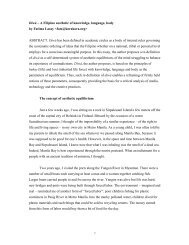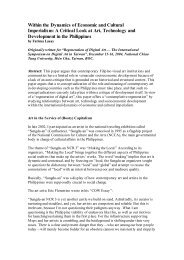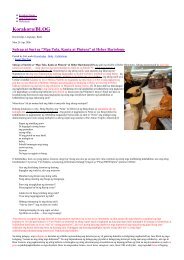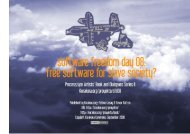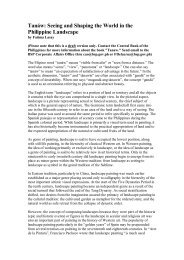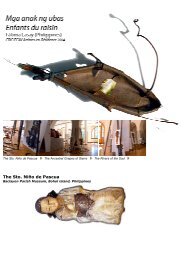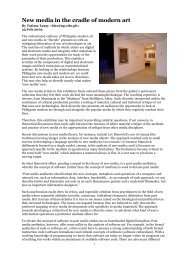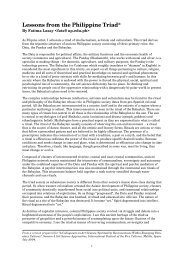Some Remarks on Language Rites/Rights - Korakora
Some Remarks on Language Rites/Rights - Korakora
Some Remarks on Language Rites/Rights - Korakora
You also want an ePaper? Increase the reach of your titles
YUMPU automatically turns print PDFs into web optimized ePapers that Google loves.
<str<strong>on</strong>g>Some</str<strong>on</strong>g> remarks <strong>on</strong><br />
<strong>Language</strong> <strong>Rites</strong>/<strong>Rights</strong><br />
by Fatima Lasay<br />
A c<strong>on</strong>cept of language in Filipino is expressed in the words "wika" and "salita" - and<br />
both words roughly translate to the English word language. Wika is traceable to<br />
sanskrit meaning family, home, or clan. Salita has more complicated (but less fluid)<br />
morphological etym<strong>on</strong> that translate roughly to word, expressi<strong>on</strong>, speech, narrati<strong>on</strong>,<br />
language, dialect, manner of speaking. In use, salita means bukal ng tunog, ritmo,<br />
lirisismo, imahe, taling-haga (bukal=natural, inherent) (ng=of) (tunog=sound)<br />
(ritmo=rhythm) (lirismo=lyricism, s<strong>on</strong>g) (imahe=image) (talin-haga=allegory,<br />
metaphor, misteryo).<br />
My definiti<strong>on</strong> of thought (and thinking) in Filipino is expressed as "diwa" and "isip."<br />
Diwa roughly translate to thought and isip roughly translate to thinking. Both diwa<br />
and isip have multiple meanings.<br />
Diwa is sense (bait, sintido, isip), c<strong>on</strong>sciousness (pamatyag = tool for observati<strong>on</strong>)<br />
(kalibutan, sankalibutan = universe; Malay/Ind<strong>on</strong>esian kesadaran), gist (buod,<br />
sumaryo, kahulugan (meaning) (Malay/Ind<strong>on</strong>esian = pokok), meaning, substance<br />
c<strong>on</strong>tained (laman, isi), spirit (espirituwal, hilagyo, kalag) (Ind/Malay=djiwa, budi),<br />
soul, life or vital principal (kaluluwa), idea (haka; Ind/Malay=faham/Filipino-paham).<br />
Isip is related to a process of thought (pag-iisip, kaisipan), understanding (unawa),<br />
sense, judgment (bait, sintido), criteri<strong>on</strong>, opini<strong>on</strong> (palagay, opiny<strong>on</strong>), discernment<br />
(tingin, paningin), idea (hinagap, hagap, wari), ingenuity (alam, kapamaaranan), talent<br />
(talino, dun<strong>on</strong>g), intenti<strong>on</strong> (tangka, balak), surmise (akala, haka), viewpoint<br />
(pananaw), and mind (which has an even more multiple meanings). Isip also is used in<br />
the word "isipan" which means "counting sticks" (noun) or palily<strong>on</strong>g pamilang.<br />
Mind is "loob", "pagkaloob", "kalooban" roughly translating to: interior<br />
(Ind/Malay=dalam), courage, valor (Ind=keberanian, Malay = berani), will, voliti<strong>on</strong>,<br />
state of mind (Ind/Malay = kehendak).<br />
Loob also has a morphological etym<strong>on</strong> which roughly translates to robbery,<br />
brigandage, a piece of fenced land, orchard, granary.<br />
<strong>Language</strong> as Rite of the Babaylan<br />
The complex relati<strong>on</strong>ships between diwa, wika and isip may be found in the ritual and<br />
philosophy of the babaylan/katal<strong>on</strong>an (whose role in Philippine society dates from<br />
pre-col<strong>on</strong>ial period). All the babaylan are interc<strong>on</strong>nected in a country itself and in the<br />
entirety of a regi<strong>on</strong> where a particular mythology is salient.<br />
This interc<strong>on</strong>necti<strong>on</strong> is seen in the ritual of the babaylan, and there are many types of<br />
rituals, but central in all these is the relati<strong>on</strong>ship of the babaylan to the sun. The sun is<br />
central to mythologies (of god (Bathala), anito and diwata) and ethnolinguistic beliefs,<br />
and mythologies have a practical aspect as they are expressed into what is called a
itual. The ritual of the babaylan c<strong>on</strong>sists of observing the sun and movement - a ritual<br />
that is the source of dance, teatro, and all the artistic and literary forms.<br />
Each babaylan holds together the physical, social, spiritual and psychological ties of<br />
each community, and the babaylan's the babaylan's inter-relating of soul and<br />
body/sensory within human - of being human) is important in this role and status in<br />
the community. Within the babaylan's c<strong>on</strong>cept of being (of being human) are the dual<br />
c<strong>on</strong>cepts of the "intellectual" and the "sensorial" and both c<strong>on</strong>cepts further present<br />
dualisms as such:<br />
1. Within kaluluwa=diwa (soul=c<strong>on</strong>sciousness): k<strong>on</strong>sept<strong>on</strong>g intelektuwal - isip/akala<br />
(thought/belief or presumpti<strong>on</strong>); dun<strong>on</strong>g/alam (knowledge/sense or wisdom);<br />
talino/talisik (intellgience/eruditi<strong>on</strong> or deep learning); hulo/hula (deducti<strong>on</strong> arrived<br />
through raciocinati<strong>on</strong>/predicti<strong>on</strong> or c<strong>on</strong>jecture).<br />
2. Within ginhawa=damdam (spirit or freedom from want=feeling or sensing):<br />
K<strong>on</strong>sept<strong>on</strong>g sensoryal - lasa/tikim (taste/to taste); kita/tingin (visi<strong>on</strong>/to see);<br />
ulinig/dinig (something heard in passing/to listen).<br />
In this complex, being is maintained or being is whole if the soul is attached to the<br />
body, but soul can be untied from the body. In Bisaya and Bikulano language, soul<br />
(kaluluwa) and untie (kalag) are syn<strong>on</strong>ymous. Soul (diwa) can be untied from body<br />
(ginhawa) when (From Z.A. Salazar, Ang Babaylan sa Kasaysayan ng Pilipinas<br />
(Quez<strong>on</strong> City: University of the Philippines Press, 1999):<br />
1. The pers<strong>on</strong> is asleep and dreaming<br />
2. When the pers<strong>on</strong> is unc<strong>on</strong>scious<br />
3. When an infant or child is "having a tantrum"<br />
4. When a pers<strong>on</strong> is sick In instances<br />
1-4, the pers<strong>on</strong>, though dismembered of the soul, remains alive.<br />
5. When a pers<strong>on</strong> dies - in this case the soul (diwa) becomes an anito (from animism,<br />
diwa becomes diwata), and spirit (ginhawa) is lost with the destructi<strong>on</strong> of the body.<br />
In this underlying complex of culture, language is at best manifested in ritual, and it is<br />
from ritual that all the arts are derived.<br />
<strong>Language</strong> and Thought<br />
Multiple perspectives may be crucial and "subversive". I'd like to speculate that this<br />
may be called "doublethink" in Orwell's '1984', and in the c<strong>on</strong>text of "the great power<br />
in legal writing at the bar and bench" (from <strong>on</strong>e of my old Anglo-Sax<strong>on</strong> law books),<br />
was used by the author to dem<strong>on</strong>ize "the enemy" (i.e. Communism). The author<br />
wrote: "But "political regenerati<strong>on</strong>" for Orwell related to those who have been<br />
seduced by the Communist mythology and thus placed in danger of being<br />
encompassed by the life lived today by milli<strong>on</strong>s of our fellow human beings in Russia<br />
and China. Those were the issues before the (UN) General Assembly and, so far as<br />
can be observed, we in this country (America) were not divided about them."
The author defined "doublethink" as the mental process by which a pers<strong>on</strong> could hold<br />
simultaneously in his mind two flat c<strong>on</strong>tradicti<strong>on</strong>s and believe both of them. And the<br />
author goes <strong>on</strong> to exemplify: "Mr. Khrushchev repeatedly exhibited his mastery of<br />
both of these arts (doublethink and newspeak); and Premier Castro showed a flair for<br />
them which, with a little hard work, could become a fully developed talent. When the<br />
latter talked of the American preference for "German warm<strong>on</strong>gering" and "Japanese<br />
militarism" as against the wholly peaceful pre-occupati<strong>on</strong> of East Germany and<br />
Communist China, he was double-thinking with a vengeance. And Mr. Khrushchev<br />
was projecting duality of thought into Newspeak when he said that NATO "has<br />
assumed the thankless missi<strong>on</strong> of exercising the spirit of freedom wherever it appears<br />
<strong>on</strong> the globe."<br />
Then the author proceeds to dem<strong>on</strong>strate how a "focus up<strong>on</strong> facts and superior<br />
abilities for clarity and forcefulness of expressi<strong>on</strong> are required" to combat these<br />
("doublethink" and "newspeak") "methods of misrepresentati<strong>on</strong>." The author refers to<br />
Churchill and to Prime Minister Macmillan as “that highly literate man” who spoke to<br />
the (UN) General Assembly pitching before Communism "a formidable traditi<strong>on</strong> of<br />
the effective use of the English t<strong>on</strong>gue" in these words:<br />
"For more than a century, it has been our purpose to guide out dependent<br />
territories toward freedom and independence. Since the Sec<strong>on</strong>d World War,<br />
India, Pakistan, Ceyl<strong>on</strong>, Ghana, Malaya, comprising over 510,000,000 of<br />
peoples have, with our help, reached the goal of independent life and strength<br />
..."
FATIMA LASAY<br />
Fatima Lasay (b. 1969) is an artist, writer/researcher<br />
and independent curator working in digital media.<br />
She is interested in articulati<strong>on</strong>s of aesthetic<br />
equilibrium in kaluluwa (knowledge), wika<br />
(language) and ginhawa (body). Lasay was artist-inresidence<br />
in Yang<strong>on</strong>, Myanmar (2004) and Sierre,<br />
Switzerland (2004), and has worked with artists and<br />
presented her work in Denmark, India, New Zealand,<br />
the Netherlands, Taiwan and the Philippines. Lasay is<br />
author of “Tanaw: Seeing and Shaping the World in<br />
the Philippine Landscape” for the book “Tanaw:<br />
Perspectives <strong>on</strong> the BSP Painting Collecti<strong>on</strong>”<br />
published by the Central Bank of the Philippines (2005), and “No Carrier and<br />
Other Stories from Philippine BBS Culture” for the book “Read_Me: Software Art<br />
and Cultures” published by the Aarhus University Press, Aarhus, Denmark (2004).<br />
Lasay was professor of industrial design, computer art and art theory (1996-2004) at<br />
the University of the Philippines where she developed its first computer art elective<br />
courses and organized the Digital Media Festivals (2000-2003). Lasay also serves as<br />
member of the editorial advisory board of the Le<strong>on</strong>ardo Electr<strong>on</strong>ic Almanac (MIT<br />
Press).<br />
(Photo courtesy of the NCCA/Metropolitan Museum of Manila)<br />
Email: fats@korakora.org / digiteer@ispx.com.ph / fats@up.edu.ph<br />
<strong>Korakora</strong> –http://www.korakora.org/<br />
<strong>Korakora</strong>/BLOG – http://blog.korakora.org/<br />
<strong>Korakora</strong>/EDU – http://edu.korakora.org/<br />
Discussi<strong>on</strong> – http://list.korakora.org/



